A Review of EA Star Wars Battlefront II and The Victory of The Consumer
Dec 21, 2017
Tatooine, the Mos Eisley Cantina, and the Galactic Empire has learned of an elite Rebel Alliance Cell hiding out and conducting operations against the Empire. Lambda-Class Shuttles land, Stormtrooper reinforcements exit from the ramp. Plastoid boots run into the close quarter confinements of the city. Rebel shouts can be heard from the opposite side. You can hear your trooper breathes heavily. Blaster fire surrounds you. It is a quick demise, but around 10 seconds later, you are refreshed with a new Stormtrooper. Suddenly green blaster bolts pelt the ground and the screech of a Tie/LN Fighter soars ahead. A T-65 X-Wing engages and the air battle begins.
Now you are in the starfield above the planet Ryloth. The Confederacy of Independent Systems has launched a surprise attack, and a fleet of Venator-class Star Destroyers hyperspace out of Ryloth to engage the gigantic Lucrehulk-class Carrier. ARC-170 fighters fill the void and Hyena Droids come to meet them. An epic crossfire ensues as the Venators move up to broadside the enemy ship.
Your lightsaber ignites with a primal hiss as Kylo Ren savagely dismembers (not really; the game is still rated T for teen) Chewbacca on Kashyyyk. Canon? No. Awesome? Yes.
Meanwhile, a meticulously crafted game— both visually and audibly— is presented with a rotten scheme. A scheme so absolutely rotten that a comment from Electronic Arts (EA), the publisher of the game, got the most downvotes in the history of Reddit. A scheme so awful that even the mainstream media picked it up. A scheme so awful that Disney themselves told EA to stop. A scheme so awful that the nation of Belgium decreed EA to be promoting illegal practices.
Background
The name of this marketing strategy? Loot Boxes. Every— and I mean every— recent AAA game, both singleplayer and multiplayer, has indulged in this greedy scheme. “Assassin’s Creed Origins,” “Middle Earth: Shadow of War,” “Call of Duty: WWII” (in which two out of its three main game modes has loot boxes), “Counter Strike: Global Offensive,” “Overwatch,” and now “Star Wars Battlefront II” have all picked up the habit of dinging you a dollar for that new Tracer skin.
Now, don’t get me wrong. Loot boxes and microtransactions are not all bad; if anything, they are just a modern trend massive publishers have preferred their games to have. However, it is how these publishers use them that they truly are the scummiest practices on Earth. Have I, as a self proclaimed “smart consumer,” bought into microtransactions and loot boxes with real world money? Yes, I have. Luckily, however, these purchases were to support companies and developers whom I trusted would put my money into improving their games.
The aforementioned Middle Earth: Shadow of War is an excellent single player experience in which these loot boxes and micro transactions are not even needed to enjoy the game. Are they welcome? No, not at all. Are they tolerable? Yes. Especially in a single player game, it can be a conscious choice to purchase the micro transactions, and in order to progress, they are not required. This is where in fact the psychology of it comes into play.
People these days do not have as much time to enjoy that new AAA $60 single player game. So companies give them that option to do so. Not everyone who plays video games is a “gamer,” and companies have realized this. Not everyone is willing to improve their own skills and would rather just pay 99 cents for that revive in “Candy Crush.” Consumption as such has driven large publishers to take many keynotes from mobile video game developers.
So when you suck at say Call of Duty: WWII and you don’t have time to become better skill-wise and level up, Activision will allow you to buy a supply drop with real-world money that could contain an experience point booster or extra in-game currency.
To gamers, however, multiplayer games should rely on skill and skill alone. In more casual settings like “Call of Duty,” players will seek that basic skill and enjoy it while still striving to get that epic gun. It is also a company’s job to balance their game at launch to allow for both non -paying players to have at least a good chance to win against the paying players. That is why high-skill games like “Counter Strike: Global Offensive” (CS: GO) only offer cosmetic items that only change the appearance of the weapon. This has also gotten Valve, the curators of “CS: GO,” into a lot of scandals; said skins can sell for hundreds and thousands of dollars in real-world markets.
In a casino, they can tell how old you are and restrict access to anyone under the age of 18. On the internet, however, anyone can lie and say they are over a hundred years old when signing up for an account. This, of course, with the help of over-reacting Youtubers, draws children and their parents’ credit cards into the fray. This is the dubious dilemma many lawmakers and even companies face. Usually, gamers continue to deal with the changing market practices of these AAA developers and their seemingly harmless strategies.
The Real Battlefront
So why did “Star Wars Battlefront II” get all of the hate? Well it all started when the gameplay trailer released. Finally, a Star Wars Battlefront game that would potentially realize the scope that all Star Wars fans had wanted. It caused hype to be had, videos to be speculated, and many memes to be made. So when EA announced there would be no season pass to split the community apart and that all future content would be “free,” every gamer knew that there had to be a catch.
When the multiplayer beta arrived, everyone groaned at the sight of loot boxes. Was it a necessary evil at the time to keep everyone playing together? Yes. The beta included three modes: Galactic Assault, Strike, and Starfighter Assault. These three game modes provided insights into the new objective-based gameplay and a focus on teamwork. In turn, everyone rejoiced with the sight of some well-needed additions.
However, the loot boxes presented an immediate problem, a problem that could potentially overshadow the gameplay. The problem was that in order to even progress your desired trooper class or starfighter class— and even to progress the heroes— you had to buy these loot boxes. So the only way to progress was not skill nor levels; it was your wallet. The prophecy had come true, a multiplayer $60 full-price game and the only way to progress was to buy these crates.
This meant that whoever had more wallet power could just bypass the game and the skill curve. Videos and articles flooded the internet. EA had hit the siren and was on damage control. They revised the loot box system but did not change it as the main progression system. DICE and EA could only do so much, and it seemed they had temporarily quelled the long-dormant anger of the gamers whose trust they had lost.
To clarify and maybe even gain some credibility with these dissuaded potential purchasers, DICE started a thread on Reddit to discuss with fans the contents of the game. It went downhill very, very fast. EA explained that in order to unlock a single hero it would cost upwards of 40,000 in-game credits. One Reddit user averaged out the amount of credits one can earn per game and came to the conclusion it would take upwards of 40-50 hours to unlock a single hero. A. Single. Hero.
To quote DICE’s Community Manager, these measures were enacted “to provide a sense of achievement and accomplishment.”
Reddit user “jHoNNy 100” replied, “This is a joke right? When you have the same currency tied to unlocking crates as you do heroes. You can swipe your credit card for crates and save up every little bit for Heroes. There is no freaking sense of pride and accomplishment in this. You are not even doing this for ‘Free DLC.’ You are doing this for items that come in your 60 dollar to 80 dollar video game. I am sure the prices or the ‘Free DLC’ will be even more egregious [sic].” Apparently, jHoNNy 100 was not alone in this statement as it received over 30,000 upvotes.
Another Reddit user figured out it would take over $2,100 in order to have every single item in the game and over 1,000 hours in in-game time to unlock all the items. EA was on full damage control.
The mainstream media had picked up on the debacle as the Reddit post had achieved over 700,000 downvotes and it continues to this day. No doubt the sirens could be heard wailing in the EA Corporate Executive Office as their idea for “games as services” was getting completely thrown down the toilet. To appease the infuriated fans— now both mainstream and “gamer” alike— EA drastically reduced the price to attain heroes just in time for their early access players. To everyone, it seemed like a cop-out and infuriated everyone more; it was not sincere, nor did it have good intentions.
It was too late; the hour of reckoning had come. EA had lost 60 percent of its sales compared to the original EA Battlefront two years prior. So the question is, how good is the base game? Is the campaign what they promised? Is at least the multiplayer fun? Let’s begin.
The link to the thread can be found here.
A Long Time Ago, The Campaign of Star Wars Battlefront II
SPOILERS AHEAD
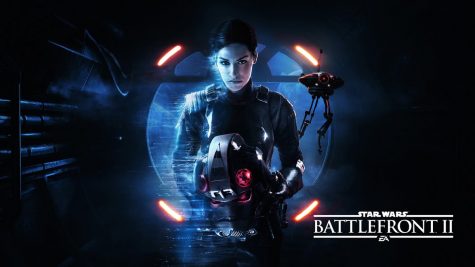
Apart from the renowned multiplayer, the second iteration of the Battlefront
series will feature a single player campaign.
There are 13 missions total within the base game of Battlefront II. A staggering 13 more than the original EA Battlefront which severely lacked a single player and was a big reason why it was critiqued. In collaboration with Criterion Games, DICE promised a mainstream view many Star Wars fans never got to see. Iden Versio— Commander of Inferno Squad and current Imperial trooper— is the main focus of the story. A rare sight to see within the new canon Disney has created.To many Star Wars fans, the Empire is the classic “evil empire” trope and may be a classic originator of said trope. However, even background characters in Star Wars have multi-page, thousand-word biographies on Wookiepedia, one of the unofficial “official” sources to literally everything related to Star Wars. Go look for yourself, it’s quite astonishing.
So when Disney gave DICE and Criterion to tell the Empire’s side of the story, albeit within the reins of the current Star Wars canon, they jumped at the opportunity. However fun and engaging, the story is predictable and hits all the notes one would expect.
Covering the tale end of the Galactic Civil War and the start of “The Force Awakens” era, you follow Iden Versio as the other titular Star Wars interact with the changing tides of the Star Wars universe. Missions deviate between vehicle, Iden, and hero. Vehicle missions focus on driving or flying many different vehicles and blasting the enemy away. They are good fun and can familiarize the player with many different vehicles and their abilities. Iden missions progress the story and character plot. Conversation permeates the atmosphere and provide some neat character interactions. Iden herself is customisable with ability cards to suit your own playstyle, but it is shallow and does not add much. Hero missions are one-off, little excerpts during the story that familiarize you with the heroes— and sometimes villains— playable within the game. Whether playing as bearded Han Solo or a battle-ready Princess Leia, they still feel shallow and not very challenging.
The differentiation between the three mission types allows for gameplay to stay fresh while the main focus of the story continues. The story ends on a cliffhanger as the campaign has yet to finish its run; more missions are coming our way during the soon-to-come multiplayer seasons. To be honest, the end felt satisfying for now and will keep fans waiting for more.
However, the difficulty of the game is extremely poor. Even playing on the hardest difficulty, the AI is extremely dumb, with only their damage and health being upped. This being said, I could not even imagine how lower difficulties play out. Though you aren’t trying to play a hard game, some true difficulty would be nice, as the only challenge is the occasional horde of Stormtroopers an an AT-ST. There is no strategy to it; simply point and click while hiding behind cover to regain health. AI does not flank, it just blindly flails at you as you mow down Stormtrooper after Stormtrooper. Poor game design like this can really break the immersion of the Star Wars universe.
As a main component of the Battlefront II experience, the campaign is serviceable. With spotty core mechanics but a solid, deliverable story it still holds up as a reason you should consider buying the game.
As an individual pillar, I would rate the campaign a 5/10, but potentially a 7/10 as the new missions could add very interesting story elements.
Let’s Get ‘Em Boys! Rebels Ahead, Clear the Area! Time To Scrap Some Clankers! Enemy Units Ahead, Identified as Republic Clone Troopers! For The First Order! For Hosnian Prime! Galactic Assault and The Problem with Star Cards
I like to believe there is a spectrum of sorts for first-person shooter mechanics. On one side, you have mil-sims such as “ARMA,” and on the other side you have arcade-style games such as Call of Duty or Battlefront I. In the middle there games like Battlefield 1 where they balance the recoil and realism with fun factor and ease of gameplay. Battlefront II lies more towards an arcade-style gameplay while retaining an easy-to-learn combat system.
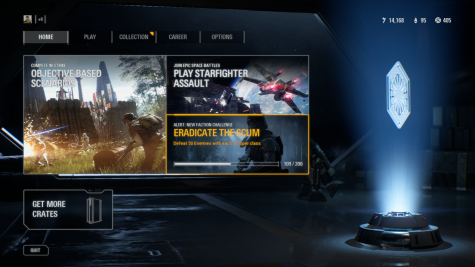
The current title screen of Star Wars Battlefield II. As you can see the loot box store is in the bottom left, not intrusive but still dark spot in video game history.
There are four main classes to indulge in and level up. “Assault” is your frontline combatant, equipped with mid-range blasters and abilities to clear rooms and disable opponents. “Heavy” is your frontline support, equipped with heavy blasters and abilities to protect teammates. The “Officer” class provides vital abilities to keep your soldier in the battle longer but with low health and can only equip blaster pistols. The “Specialist” is your long range glass cannon damage-dealer, equipped with long-ranged blaster rifles.
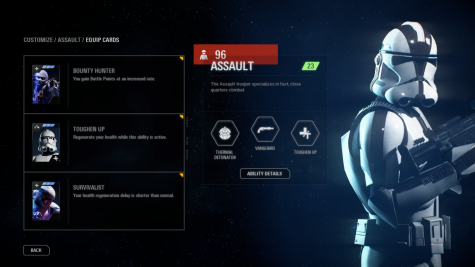
The Clone Trooper Phase II as seen during the Battle of Theed in Galactic Conquest. Currently equipped with the A280 Blaster Rifle.
Unfortunately, when it comes down to a metagame— or long-term strategies used by players— it just is non-existent. Yes, each class has different weapons, but the Heavy is just a slower, higher-HP version of the Assault class. Compared to Battlefield 1, another strict class-based game, each class has a unique role they must play in order to see the success of their team. Assault players take objectives but can also serve as tank-busters or even a mid-range damage-dealer. Medics play a pivotal role in keeping your team healthy, but can also snipe with semi-automatic weapons, providing a diversity in combat roles. The Scout can either serve as a backlines sniper or front lines sharpshooter who can also disable vehicles. The Support class supplies ammunition and can provide actual suppressing fire.
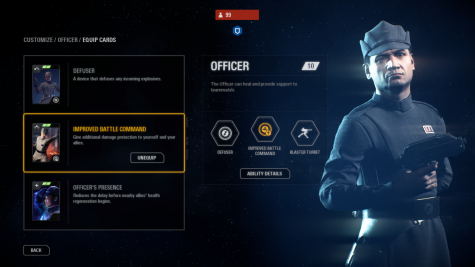
In Battlefront II, you feel none of that cohesion or sense of teamwork. The Assault and Heavy classes are interchangeable, and when it comes down to picking one of them, barely any thought needs to be put in. The Specialist has snipers and no other use than just sitting at the back of the map and taking pot shots. The Officer is ironically the least adaptable, as grenade and explosion spam instantly blows you away with your limited health. So when entering a match, it feels as though only two or three classes will ever be at play at once, devolving the impact of “team based” gameplay.
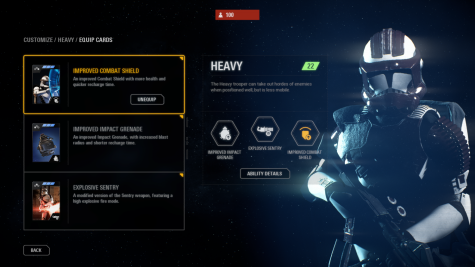
In the previous Battlefront game, Star Cards were interchangeable for each trooper and not restricted to a single class. They provided bonuses like a jump pack or an ion rocket. In Battlefront II, Star Cards are the main abilities of each class.
There are two types of cards; booster and ability cards. Boosters are passive effects applied to your trooper while ability cards change or enhance your current set. Assault, for instance, has the Vanguard, Tracker Dart, and Thermal Detonator as the base abilities. Vanguard gives you a slugthrower (shotgun) and increased speed for a short amount of time, Tracker Dart reveals enemy positions over a small area, and Thermal Detonator is your basic grenade. “Toughen Up” is an ability card that can be used in tandem with Vanguard that regenerates health while moving fast with a powerful weapon. As basic set-ups or just different abilities, they work fine and add deviation to the gameplay.

However, they can be upgraded to stack percents or modifiers. To upgrade these modifiers, you have to have a proper Star Card rank. The only way to increase your Star Card rank is to either buy crates that will drop new Star Cards or craft them with crafting parts. So when one can just swipe their credit card endlessly to acquire cards, you can see where it is pay to win. Don’t worry; when EA changed the progression system, one of the things to gain a sense of “accomplishment” was the fact that in order to upgrade further or acquire different levels of Star Cards you had to reach a minimal player level first.
After playing two to three weeks after launch, it can be confirmed that Star Cards are— and will be— pay to win and extremely unbalanced. If a Heavy trooper and Assault trooper were to duke it out head to head with no Star Card upgrades, player skill would overcome overpowered abilities. When the general player base starts leveling up and acquiring more Star Cards, be prepared to get cheesed during the match. For the Heavy trooper, they can increase their personal shield up to 50% and it is next-to-near impossible to break the shield one-on-one. The Assault trooper can acquire an improved Thermal Detonator in which you cannot roll out of or it instantly kills you. The Specialist can acquire abilities that are essentially wall hacks or an extremely limiting shock grenade. The Officer can give massive buffs and have overpowered turrets. So just imagine that all of this so far has been grinded by players over a course of two to three weeks. When the ability to swipe your credit card arrives, it will be blatantly insulting and pay to win, destroying the integrity of the Galactic Assault gamemode and EA’s integrity in general.
In the original Battlefront, Star Cards were balanced and presented a elementary yet fun way to play your trooper. As the game was further balanced, you never felt like it was an unfair death or game-breaking ability. This is the exact opposite feeling one gets from playing Galactic Assault.
To accommodate for the lack of credit-card swiping tactics, EA stunted credit acquisition rate, slogging the game to a halt. No longer do you feel like you can accomplish actual goals, but rather just more credits to endlessly spend. There has recently been a credit boost done by DICE to encourage sales and to gain some of the lost trust of their fan base. Originally, you could only earn up to around 100 to 500 credits, with 100 credits being the least you could acquire in the game and 500 if you completely dominated that game. To get a Trooper Crate, it costs 4,000 credits and it will take eight games in which you completely dominate the battlefront. The Starfighter Crate is 2400 credits, and the Hero Crate is 2200 credits, each one with varying degrees of rarity and drop rate, meaning that it could take a while until you even get your favorite trooper or starfighter to level up.
A very disappointing aspect of Battlefront II are the blasters, and if there is anything that makes a first-person or third-person shooter, it is its weapons. There are the base weapons for each class; Assault Clone Troopers have the DC-15 Blaster Carbine and the Droids have the E-5 Blaster Rifle. These base weapons cannot be interchanged in-between eras and have no differentiation in terms of recoil or spread, restricting experimentation for players. Then there are the unlockable weapons, which are very disappointing to unlock.
For example, the Rebellion’s A280C, an automatic blaster, can be replaced with one of the three unlockable Assault weapons called the A280. The only difference is that it has burst fire. The Heavy Clone Trooper has the DC-15 Heavy Blaster which can be replaced by the DC-15LE, which just has the ability to have modifications.
Speaking of modifications and different blasters, the only way to get new blasters for each class is to get “x kills” with said class. How original. In the original Battlefront, “Hutt Contracts” were unique to each weapon, and each weapon felt unique. The DL-18, for example (which could have been an excellent blaster for the Officer class), required “X amount of kills with blaster pistols, x amounts of headshots and x amount of assists.” When the task was complete, you received the weapon. It was actual investment, actual achievement. The A180 blaster had three different firing modes; ion, rifle, and targeting rifle. To do so you had to get “x amounts of kills with each type of weapon.” When you finally got the blaster, the sense of accomplishment washed over you and you felt good that you had finally got it.
One thing DICE added was the “Battle Point” system. Instead of having arcade-style pickups around the battlefront, you have to earn that AT-ST or jump trooper, and especially for heroes. Even starfighter support can be called in to take control over the skies. These Battle Points are gained by playing the objective, killing enemies, destroying vehicles, and supporting teammates.
*
As cool as it is to blast Imperials with an X-Wing, I can tell you from playing that no one plays the objective. After it was so pleaded to DICE to provide more contextual and impactful objectives, players refuse to start the hack or shoot the biggest thing on the map (being an AT-AT or MTT), leading to losses that could have easily turned into victories. The game is incredibly satisfying when you get a rare, long game. A heated battle spanning the battlefront and the game truly shines flaws and all.
At this point you must be wondering, “what about the heroes?” Well, they are amazing when you get to use them for five seconds. This five seconds is either due to the game ending because players refuse to play smart and just throw themselves at the objective and you now only acquire the hero. Then you could have 10 people shoot you with high-powered abilities and end your long-awaited run as Darth Vader or Luke Skywalker.
This is not to mention that heroes also have Star Card abilities— and yes— they can make heroes incredibly overpowered, and suddenly, the team has a third objective. This can either be fun or extremely infuriating as your limited supply of troops is cut down by Kylo Ren wave after wave. Smart players will corner and unleash hell on who is hopefully a decent player, but most of the time, you and your friends will just be cut down from a mile away.
In the original 2005 Battlefront II, heroes played the same role. Instead, however, if one played as Obi-Wan or Darth Maul, they would have the same strength as each other but have different abilities or animations, thus providing balance and fairness.

Overall, the Galactic Assault game mode is good fun for short bursts but remains lacking in its core mechanics and suffers from broken gameplay systems. When the game shines, its flaws only peak while at your own worst. But when the game is not shining, prepare to feel cheesed and exploited by the unfair marketing systems EA has employed to get people to potentially swipe their credit cards.
The Galactic Assault and Trooper game modes severely lack cohesion and strategy. Delving into the same two to three classes is boring after a couple hours and seriously inhibits replayability. Unlocking modifications or getting new blasters is bland and unsatisfying, resulting in a lack of drive to acquire said weapons and progress through the game. The graphics and sound design are beautiful but cannot hold up the rest of the game.
Unfortunately, Galactic Assault gets a 3/10 for having exploitable market practice.
Death Stars, Venators, Star Destroyers, MC-80s, and Munificence: Starfighter Assault and the slim hope for Battlefront II.
Surprisingly, the overwhelmingly okay part of Battlefront II is not the part made by DICE. Motive Studios who had previously developed the X-Wing VR missions were given full reign to engage enemy fleets and fire away.
Strictly resigned to starfighter combat, Starfighter Assault incorporates objective-based gameplay with the epic space battles we have always wanted.
A personal favorite map of mine is the Fondor Shipyards, showcasing an Alliance Fleet assaulting a docked Imperial Class Star Destroyer. Starting off with Rebel Fighters destroying Arquentin-Class Light Cruisers, TIE Fighters meet them in combat. Showcasing the difference in power, the Alliance focuses on starfighter endurance while the Empire focuses on sheer numbers and swiftness of the TIE Fighters. It progresses to the innards of the shipyard after which an Alliance Capital ship moves in to deal with the Star Destroyer. Unlike the first EA Battlefront, capital ships are right here, in your face, and truly representative of the massive power of the Empire.
The scale immerses you along with the beautiful graphics and sound. Players are finally given a firsthand view of the Lucrehulk Core Ships from the Clone Wars and their massive size or the Venator Star Destroyer and the Imperial Star Destroyer, its grandson.
There are three types of fighter for each faction; Fighter, Interceptor, and Bomber, The Fighter is well-rounded and can deal damage to both objectives and enemy fighter dually. The Interceptor is regulated to fast-firing and fast-moving tactics, meant to take down enemy fighters attacking bombing runs. The Bomber is used for destroying objectives and dealing heavy damage to subsystems on cruisers and destroyers.
By far the most powerful set of three has to be the Rebel Alliance. In lore, the Rebel Alliance has had the best starfighters and pilots, even comparing to the Clone Wars and the Old Republic. In the game, the X-Wing is devastating, the A-Wing has rapid fire and shields, and the Y-Wing has high health and an auto turret to boot.
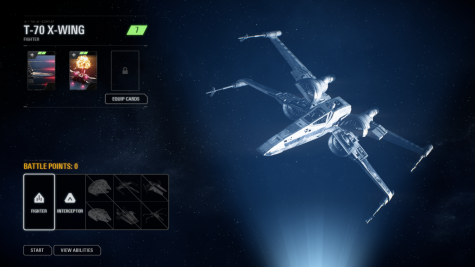
The T-70 X Wing of the Resistance. Along with the ARC-170, Vulture Droid, T-65 X Wing and TIE Fighter, the fighter class dominates the battlefield.
Hero ships provide unique experiences and abilities. Whether it is Luke’s Red Five or Kylo Ren’s Tie Silencer, they are balanced as best as they could be and are fun to fly on the battlefront.
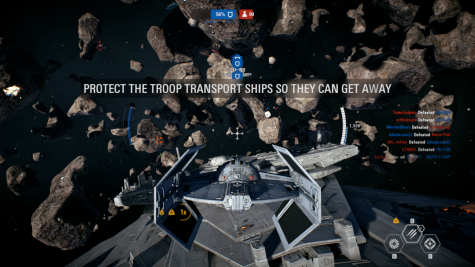
Star Cards do not adversely affect gameplay as much as they do in Galactic Assault, as Starfighter Cards are harder to acquire than normal trooper cards. After the two to three week period, Starfighter Assault is still more skill-based than overpowered-ability-based.
However, the experience is still limited and feels like it could use more (much like the rest of the game). No capital ship-boarding or ground-to-space combat and the mode just feels a tad above average.
Starfighter Assault is an above average playing experience with good controls and a very fun set of maps. It almost carries the fault of the previous two pillars of this game but can’t handle all the weight itself.
As its own score, Starfighter Assault earns a 6/10.
Conclusion and a To Be Continued…
The controversy is not over yet and EA still has yet to re-implement microtransactions. Battlefront II as a game is not even complete yet. As a consumer, I urge you not to buy this game until it is all sorted out. It doesn’t matter if it is Star Wars or whatnot, do not waste your money for a game and company that does not respect nor encourage its consumers. Does this stop Battlefront III from coming out? No, but it shows every other AAA publisher that gamers and casuals alike will not stand for greed in a medium that we hold dear.
If I could give this game a true score, EA’s Star Wars Battlefront II would earn a 0/10 in total.
To give you a true review however EA’s Star Wars Battlefront II earns a total score of 13/30. Earning a less than a F score this game is not yet viable for you as a consumer to fully trust and experience.As the saying goes, ”If you can’t handle it at its best, you cannot handle it at its worst.”


Ethan ◊ Jan 12, 2018 at 11:23 am
I don’t think the comparison with Overwatch is completely fair. There’s a big difference between their system: Battlefront 2’s loot boxes give you items that give you a blatant advantage in gameplay, while Overwatch has skins. Overwatch has optional skins which are purely for aesthetic, so you never need to get boxes to have a chance at winning, and I think the natural ways of getting boxes by just playing the game goes at a nice pace. Meanwhile, it takes decades to get one box in Battlefront 2, and since it has random stuff, you’re probably going to get mostly random and useless items, so you’re basically forced to spend money to have a chance at all of getting a good item that will either make the game more balanced or make you overpowered depending on how much the other players in that match have spent. Most people call it “pay-to-win”, since you can buy advantages over others.
So basically, Overwatch’s boxes are optional and don’t make the game unfair, meanwhile Battlefront 2’s boxes are almost necessary to play the game. I don know about any of the other comparisons, since I haven’t really played any of those other games, but yeah, just a thought.
Max Quirin ◊ Jan 9, 2018 at 1:38 pm
This article was great, can you do a review of one of the best games of all time, the witcher 3 wild hunt game of the year edition?
Darius Rahmanian ◊ Jan 9, 2018 at 2:07 pm
Time is a big factor for me when writing reviews of any sorts. Usually I play a game for 30-50 hours before I can write a full review. When it comes to RPG’s you usually need to play the entire game plus DLC’s. Withcer 3 is such an amazing and great game but I need time for it. I could give you a review but it would take over a hundred hours on average to complete. Plus I have other games I want to play. But its never not an option